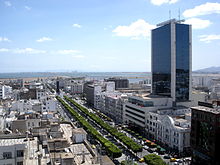Economy of Tunisia

Tunis
|
|
| Currency | Tunisian dinar (TND) |
|---|---|
| Statistics | |
| GDP |
$49.63 billion nominal (2014) $124.7 billion PPP (2014) |
|
GDP growth
|
2.3% (2014) |
|
GDP per capita
|
$4329 (2014) |
|
GDP by sector
|
agriculture: 11%; industry: 35.3%; services: 53.7% (2009 est.) |
| 6.04% (July 2014) | |
|
Population below poverty line
|
15.5% (2010) |
| 36.1 (2010) |
|
|
Labour force
|
3.315 million (2013) |
|
Labour force by occupation
|
agriculture: 18.3%; industry: 31.9%; services: 49.8% (2009 est.) |
| Unemployment | 15.3% (July 2015) |
|
Main industries
|
petroleum, mining (particularly phosphate and iron ore), tourism, textiles, footwear, agribusiness, beverages |
| 77th (2017) | |
| External | |
| Exports | $16.75 billion (2014) |
|
Export goods
|
clothing, semi-finished goods and textiles, agricultural products, mechanical goods, phosphates and chemicals, hydrocarbons, electrical equipment |
|
Main export partners
|
|
| Imports | $24.83 billion (2014) |
|
Import goods
|
textiles, machinery and equipment, hydrocarbons, chemicals, foodstuffs |
|
Main import partners
|
|
|
FDI stock
|
$31.86 billion (31 December 2009 est.) |
|
Gross external debt
|
$27.86 billion (2014) |
| Public finances | |
| 50.03% of GDP (2014) | |
| Revenues | $11.89 billion (2014) |
| Expenses | $13.66 billion (2014) |
|
|
|
Foreign reserves
|
US$7.047 billion (October 2015) |
$49.63 billion nominal (2014)
Tunisia is in the process of economic reform and liberalization after decades of heavy state direction and participation in the economy. Prudent economic and fiscal planning have resulted in moderate but sustained growth for over a decade. Tunisia's economic growth historically has depended on oil, phosphates, agri-food products, car parts manufacturing, and tourism. In the World Economic Forum Global Competitiveness Report for 2015-2016, Tunisia ranks in 92nd place. Based on HDI latest report (for 2014), Tunisia ranks 96th globally and 5th in Africa.
The year 2015 was marked by terrorist attacks in Tunisia which are likely to impact economic growth, especially in tourism, one of the main sectors.
GDP per capita soared by more than 380% in the seventies (1970–1980: USD 280–1,369). But this proved unsustainable and it collapsed to a cumulative 10% growth in the turbulent eighties (1980–1990: USD 1,369–1,507), rising again to almost 50% cumulative growth in the nineties (1990–2000: USD 1,507–2,245), signifying the impact of successful diversification.
Growing foreign debt and the foreign exchange crisis in the mid-1980s led the government to launch a structural adjustment program to liberalize prices, reduce tariffs, and reorient Tunisia toward a market economy in 1986. Tunisia's economic reform program was lauded as a model by international financial institutions. The government liberalized prices, reduced tariffs, lowered debt-service-to-exports and debt-to-GDP ratios, and extended the average maturity of its $10 billion foreign debt. Structural adjustment brought additional lending from the World Bank and other Western creditors. In 1990, Tunisia acceded to the General Agreement on Tariffs and Trade (GATT) and is a member of the World Trade Organization (WTO).
...
Wikipedia
